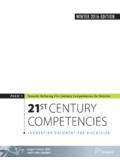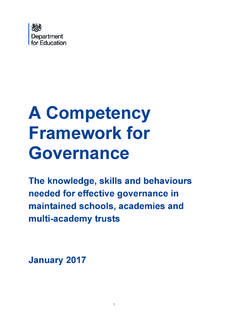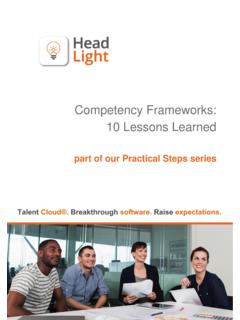Transcription of TEACHING AND LEARNING IN COMPETENCY …
1 The Fifth International Conference on e- LEARNING (eLearning-2014), 22-23 September 2014, Belgrade, Serbia TEACHING AND LEARNING IN COMPETENCY - based education . NEIL O'SULLIVAN. Innovative Together Ltd, DR ALAN BURCE. Universal LEARNING Systems Abstract: There is a growing trend towards COMPETENCY based education in Europe this is emphasised by the implementation of European Key COMPETENCY framework in many duristinctions. This paper reflects on the attributes of COMPETENCY based education its domains and TEACHING approaches for effective COMPETENCY TEACHING and LEARNING . Keywords: E- LEARNING , COMPETENCY based education Competences as defined by European bodies, as 1.
2 INTRODUCTION well as by educational experts, to consist of three TEACHING and LEARNING in any curriculum require interrelated ingredients: common goals, shared responsibility and accountability between teachers and learners, and 1. A knowledge component (the understanding supportive or enabling environments to maximize part), success in LEARNING . Effective LEARNING is LEARNING 2. A behavioural components (the overt which is lasting and capable of being put to use in behavioural repertoire) and new and differing situations. LEARNING has 3. A value component (including values, beliefs traditionally been conceptualized as theory based on and attitudes).
3 Academic frameworks where achievement is judged by the ability to recall key points, information So a competent person performing a task will imparted or details and sequences memorized. The possess a combination of skills, knowledge, leap from this to the ability to recall, act and perform attitudes, and behaviours required for effective to set standards of ability and expertise is the leap to performance of the task or activity. A competence is a framework based on competence. This paper defined as the holistic synthesis of these discusses COMPETENCY in TEACHING and LEARNING . It components. At another level, a competence again further examines the type and form of LEARNING may be divided in three components or aspects.
4 Strategies which promote COMPETENCY - based LEARNING . It is the ability of a person to show: We first define COMPETENCY - based education . Then 1. A particular behaviour in we review COMPETENCY - based education and the 2. A particular context and with domains and specific attributes of teachers and 3. A particular quality. learners that are required to make COMPETENCY - based education successful. This is followed by a Defining COMPETENCY is complex, and an educational brief discussion identifying COMPETENCY - based COMPETENCY even more so. The Organization for objectives and the TEACHING methods and LEARNING Economic Cooperation and Development (OECD). activities that contribute to COMPETENCY through PISA, (Programme for International Student development.)
5 We finish with the key qualifications Assessment) has done much work on defining points of COMPETENCY - based education . competencies, and created a framework for comparing student competencies for purpose of 2. WHAT IS COMPETENCY - based assessment. A report completed by PISA states: education ? A COMPETENCY is more than just knowledge and skills. It involves the ability to meet complex demands, by drawing upon and 71. mobilising [mobilizing] psychosocial resources (including skills and attitudes) in a particular context. For example, the ability 4. TEACHING AND EFFECTIVE. to communicate effectively is a FACILITATION OF COMPETENCY . DEVELOPMENT. COMPETENCY [PISA].
6 Competence based education programs build 3. COMPETENCY - based TEACHING from the idea that it is more important to focus on outcomes what a student knows and can The attributes of COMPETENCY - based TEACHING are do than on inputs like how the student learns it, listed below. These teacher characteristics and where the student learns it, or how long the expectations contribute to learner success. They student takes to learn it. This break from inputs also demonstrate the shared responsibility of means that CBE programs are free to explore teachers and learners to reach the goal of new ways to help students learn and new competence. The most important characteristic of dimensions of what constitutes a course.
7 Some COMPETENCY - based education is that it measures CBE programs are designed to allow students to LEARNING rather than time. Students progress by learn in a variety of formats, sometimes drawing demonstrating their competence, which means they on open educational resources (including written prove that they have mastered the knowledge and materials, videos, recorded lectures, etc.) or skills (called competencies) required for a particular hands-on, project- based LEARNING . Many course, regardless of how long it takes. While more programs are also designed for students to traditional models can and often do measure progress at their own pace, rather than at a pace COMPETENCY , they are time- based -- courses last dictated by semesters or credit hours.
8 This about four months, and students may advance only means that motivated and efficient students can after they have put in the study or application time. complete their degrees in less time. This is true even if they could have completed the coursework and passed the final exam in half the TEACHING strategies need to be matched to the time. So, while most colleges and universities hold domain of LEARNING . We briefly outline the time requirements constant and let LEARNING vary, various domains and how a COMPETENCY - based COMPETENCY - based LEARNING allows us to hold curriculum may be implemented and the LEARNING constant and let time vary. strategy that may be chosen.
9 Attributes of COMPETENCY - based TEACHING Understand how learners learn Psychomotor domain: Match principles of LEARNING and TEACHING Demonstrate the expected way to Facilitate, rather than control LEARNING perform a given skill. Allow the learner Model humility, critical thinking, respect, to practice for a while, and then ask for COMPETENCY & caring at all times a return demonstration of that skill. Support acquisition of knowledge, skills &. professional behaviours in all LEARNING Set up models or create a simulation domains (cognitive, psychomotor, affective) exercise in the practical laboratory Promote & expect learner accountability for where learners can have repeated LEARNING practice of skills with peers and/or Provide timely, specific feedback on learner teacher supervision.
10 Progress beginning with learner self- assessment Individualize LEARNING experiences according Arrange for sufficient practical to needs experiences requiring skill performance Expect increasing complexity of of the competencies under direct performance as the learner progresses supervision. throughout the programme 72. Create a valid and reliable assessment with fellow learners and teachers. It is important tool for use in determining COMPETENCY that teachers provide ample time for in skill demonstration. discussion/dialogue and clarification of concepts to be learned. They also need to encourage and Affective domain: help the learner use their own knowledge and Create values clarification exercises ideas to find possible solutions.









